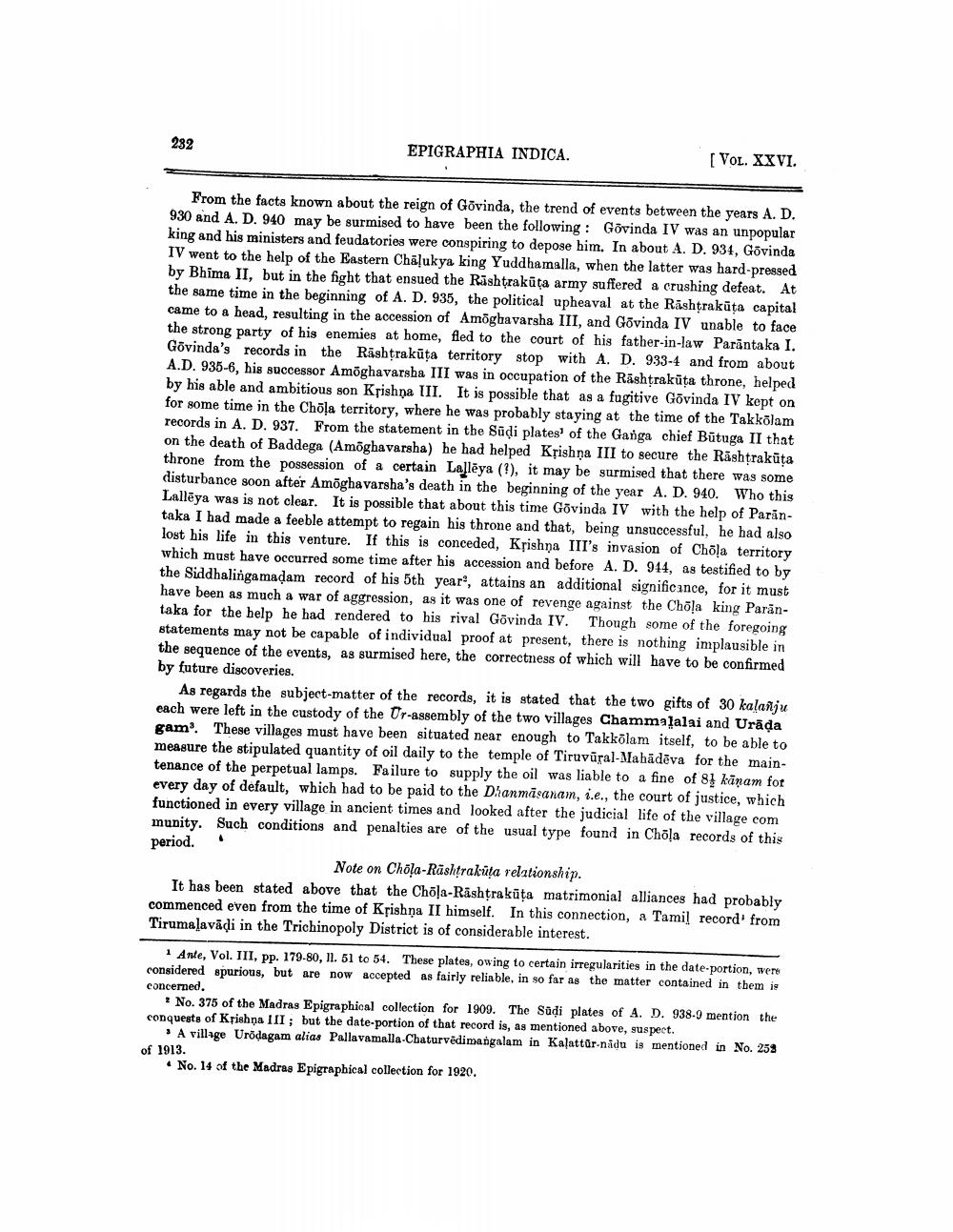________________
282
EPIGRAPHIA INDICA.
[VOL. XXVI.
From the facts known about the reign of Govinda, the trend of events between the years A. D. 930 and A. D. 940 may be surmised to have been the following: Govinda IV was an unpopular king and his ministers and feudatories were conspiring to depose him. In about A. D. 934, Govinda IV went to the help of the Eastern Chāļukya king Yuddhamalla, when the latter was hard-pressed by Bhima II, but in the fight that ensued the Rashtrakūta army suffered a crushing defeat. At the same time in the beginning of A. D. 935, the political upheaval at the Rashtrakūta capital came to a head, resulting in the accession of Amõghavarsha III, and Govinda IV unable to face the strong party of his enemies at home, fled to the court of his father-in-law Parantaka I. Govinda's records in the Rashtrakūta territory stop with A. D. 933-4 and from about A.D. 935-6, his successor Amoghavarsha III was in occupation of the Rashtrakūta throne, helped by his able and ambitious son Krishna III. It is possible that as a fugitive Govinda IV kept on for some time in the Chõļa territory, where he was probably staying at the time of the Takkõlam records in A. D. 937. From the statement in the Sudi plates of the Ganga chief Būtuga II that on the death of Baddega (Amöghavarsha) he had helped Křishna III to secure the Răshtrakūta throne from the possession of a certain Lallēya (?), it may be surmised that there was some disturbance soon after Amõghavarsha's death in the beginning of the year A. D. 940. Who this Lallēya was is not clear. It is possible that about this time Govinda IV with the help of Parantaka I had made a feeble attempt to regain his throne and that, being unsuccessful, he had also lost his life in this venture. If this is conceded, Krishna III's invasion of Chõla territory which must have occurred some time after his accession and before A. D. 914, as testified to by the Siddhalingamadam record of his 5th year, attains an additional significance, for it must have been as much a war of aggression, as it was one of revenge against the Chola king Parantaka for the help he had rendered to his rival Govinda IV. Though some of the foregoing statements may not be capable of individual proof at present, there is nothing implausible in the sequence of the events, as surmised here, the correctness of which will have to be confirmed by future discoveries.
As regards the subject matter of the records, it is stated that the two gifts of 30 kalanju each were left in the custody of the Ur-assembly of the two villages Chammalalai and Urāda gam. These villages must have been situated near enough to Takkõlam itself, to be able to measure the stipulated quantity of oil daily to the temple of Tiruvūral-Mahādēva for the maintenance of the perpetual lamps. Failure to supply the oil was liable to a fine of 81 kūnam for every day of default, which had to be paid to the Dhanmāsanam, i.e., the court of justice, which functioned in every village in ancient times and looked after the judicial life of the village com munity. Such conditions and penalties are of the usual type found in Chöla records of this period.
Note on Chöla-Rashtrakūta relationship. It has been stated above that the Chõla-Rashtrakūta matrimonial alliances had probably commenced even from the time of Krishna II himself. In this connection, a Tamil record from Tirumalavādi in the Trichinopoly District is of considerable interest.
1 Ante, Vol. III, pp. 179-80, N. 51 to 54. These plates, owing to certain irregularities in the date portion, were considered spurious, but are now accepted as fairly reliable, in so far as the matter contained in them is concerned.
No. 375 of the Madras Epigraphical collection for 1909. The Sadi plates of A. D. 938-9 mention the conquests of Kțishna III ; but the date portion of that record is, as mentioned above, suspect.
A village Urödagam alias Pallavamalla-Chaturvedimangalam in Kalattor nadu is mentioned in No. 259 of 1913.
No. 14 of the Madras Epigraphical collection for 1920.




